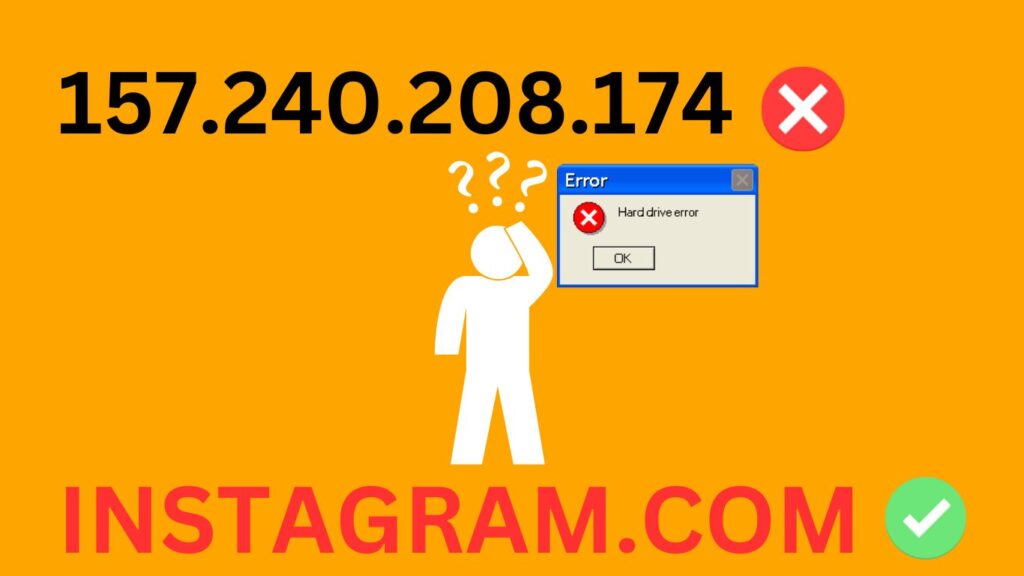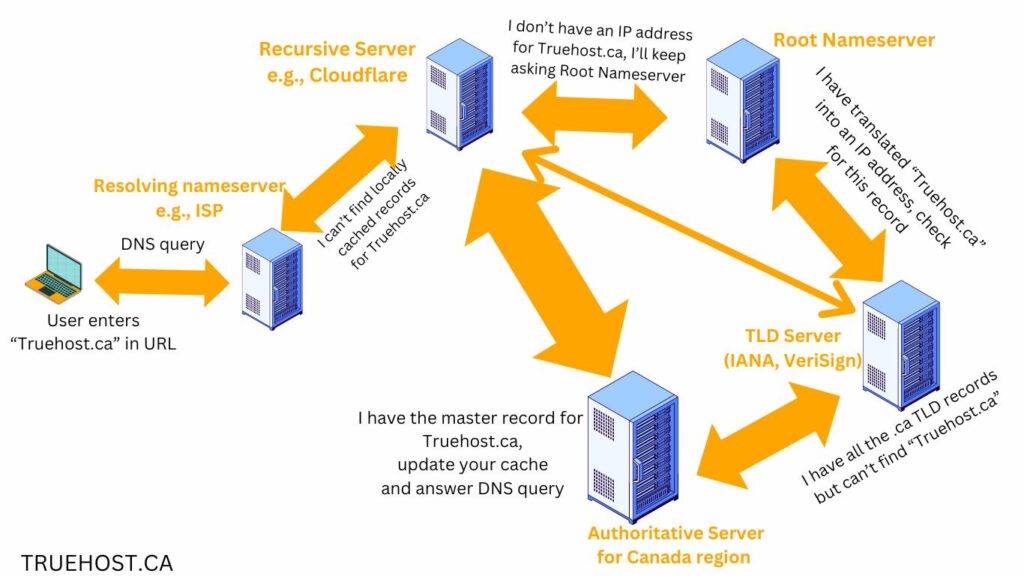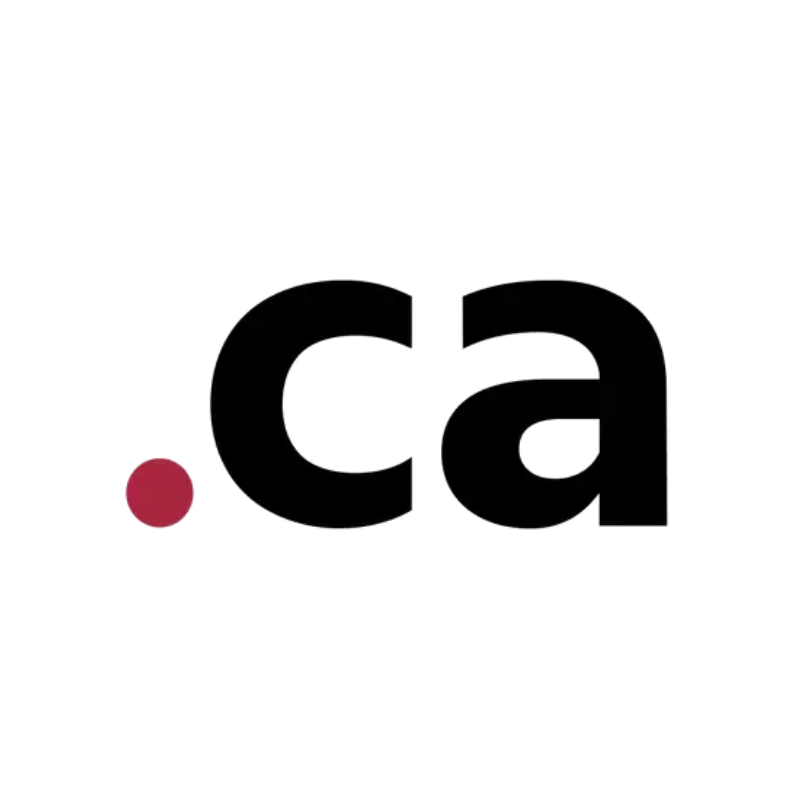Last updated on March 18th, 2024 at 12:30 pm
The first step of creating a website is to buy and register a domain. A website’s domain name is incredibly important for SEO and brand recognition, and will directly affect how much revenue your website earns.
Unfortunately, many beginners in e-commerce get confused by domain names, URLs, website names, and website hosting. We’ll see shortly that domains exist to serve human memory, and this knowledge could help you gain a huge advantage over competitors.
This third part of our website design guide covers website names in greater depth. You’ll understand what domains are, how to register a domain name, and how DNS comes into the picture.
It’s not easy to choose a domain name, but we have a detailed guide on business and domain name selection.
What Is a Domain Name and How Does It Work?
A domain name is a unique, human-readable string of characters that serves as the internet address for your website. For example, Truehost.ca is the unique domain for this website, and no other site can have that exact domain.
You see, computers identify websites by their IP addresses. But it’s incredibly difficult to remember all those strings of numbers.
Imagine having to enter 157.240.196.0/24 every time you wanted to visit Facebook or 157.240.208.174 for Instagram.

So, while computers are perfectly happy working with IP addresses, we humans need domain names to find websites.
Each domain name is unique and linked with the site’s IP address. A special system called the Domain Name System (DNS) translates domains into IP addresses so that computers can find the website you want.
This way, it becomes easy to find and remember all the different websites we visit. But that also means domains need to be administered by a central authority to eliminate duplicates and manage the DNS system—more on that shortly.
Who owns a domain name?
Domains belong to whoever registers them with a domain registrar.
But nobody actually owns a domain name, they only lease them for a set period. That’s why domain subscriptions can expire and be purchased by someone else.
When you buy a domain name, you’re really purchasing the exclusive right to use that domain for a certain period, usually a year, two years, or more up to a maximum of ten years.
Domain names are managed by domain name registries, which maintain records of who owns all existing domains, what IP addresses are associated with them, and how to handle queries or requests directed to each one.
A domain registry is any organization that manages top-level domains, which are the ones with extensions such as .com, .net, .gov, .org, .edu, and .ca. The registry creates these extensions, sells them (via domain registrars) to users, and controls their use.
For example, VeriSign is one of the largest domain registries and is in charge of the .com domain.
What is a domain registrar?
While domain registries have an administrative role, domain registrars handle the sale and registration of domains. They also provide technical support on behalf of domain registries.
In return, domain name registrars are allowed to add a small markup to the domain price and make a little profit this way.
For example, Truehost Canada is an accredited global domain name registrar. You can check domains, search for unused domains, and register them right here on our website.
And you, dear reader, become a domain registrant once you buy and register a domain. You get a unique record in the DNS database, and you can manage your DNS records through your domain provider.
Expert tip: It is your responsibility to ensure that your domains point toward your site’s IP address. You should also keep up with domain renewals; it’s easy to lose a domain if you forget to set up automatic renewal or use outdated credit card information. Truehost always notifies customers of domain expiry well in advance to prevent domain loss.
Who is ICANN and IANA?
The Internet Corporation for Assigned Names and Numbers (ICANN) is the global administrator of all domains and IP addressing systems. It is a non-profit organization that maintains the central database of IP addresses and controls the supply of new ones.
ICANN also coordinates the operations of all domain registries worldwide to ensure no conflicts in IP addressing. Thus, domain registration and the entire DNS system fall under the organization’s oversight and authority.
ICANN has a special department called the Internet Assigned Numbers Authority (IANA) which manages the root nameservers of all TLDs worldwide.
Domain Whois lookup
If you haven’t heard about Whois, it is a tool that allows anyone to discover publicly available information about domain registrants.
In other words, Whois allows you to find the owner of any website by searching the domain or IP address.
ICANN requires every domain registrant to provide accurate and up-to-date contact information when registering a domain. This information is necessary useful in finding website owners and and settling legal problems, especially trademark and intellectual property rights disputes.
If you want to know who owns a particular domain, find its registration information by conducting a WHOIS search. Use our free WHOIS search tool to get information about any currently registered domain names.
ICANN also runs a lookup tool, which is great if you want to find records for a domain registered in a different region of the world.
Expert tip: If you don’t want your information being displayed publicly on Whois, buy domain privacy. Your hosting company, such as Truehost, will display alternative forwarding details on Whois searches instead of your personal information, unless it is a legal request (such as by lawyers or law enforcement).
Types of Domains and Domain Levels
When people talk of types of domains, they usually mean Top Level Domains (TLDs). That’s the part that comes after the domain name, such as .com, .net, .gov, .org, .edu, and .ca.
After top-level domains, we have second-level domains. That’s the actual domain name, such as “Truehost” in “https://truehost.com”. Some URLs also have country code second-level domains, such as .co.uk used for domains in the United Kingdom and .gov.au for Australian government sites.
Third-level domains are the portion of the domain that comes before the actual domain name. For example, in the domain www.truehost.com, the www part is a third-level domain.
Some websites also have a completely different mobile website labeled m.example.com or something similar. The image below illustrates the domain hierarchy.

Note that a third-level domain is different from the protocol (http or https). The protocol or scheme is only found in a URL.
You don’t really need to add www to your domain. It used to be useful to separate the main website www.example.com from other parts of the site, such as mail.example.com. That’s no longer necessary, but you should ensure your site works with or without this subdomain.
Important!: Most websites work with or without the www subdomain. However, you should configure your site so that users can find it whether they enter the URL in the form example.com or www.example.com. Set up a 301 redirect to do that, and add redirects for common mistypes such as ww.example.com.
Domain vs URL: What’s the difference?
To understand domains, we have to talk about URLs. First, you should note that a domain is the name of a website. For example, Truehost.ca is a domain, as is truehost.com.
On the other hand, a URL is a more complete form of a domain that a browser can use to visit the website. It’s the actual, human-readable internet address of that website. For example, https://truehost.ca is the URL of the domain Truehost.ca.
That means a domain is part of a URL. We covered the parts of a URL in Part 2 of this series, but they’re also shown in the image below.

Even though a domain is technically different from a URL, the two are more or less the same in normal use. Modern browsers recognize the two, so using truehost.ca in your browser is the same as typing https://truehost.ca.
What Are TLDs (Top-Level Domains)?
A top-level domain (TLD) is the part of the domain or URL that comes after the domain name. A TLD is also known as URL extension, domain suffix, or domain extension.
The main TLDs include .com, .net, .gov, .org, and .edu, but many more exist. TLDs indicate the type of organization that owns the website.
There are five main types of TLDs:
- Generic TLDs (gTLD) – these are the most common and popular domain extensions, such as .com and .org. Anyone can have a gTLD, although some of them are restricted. Other examples of gTLDs include the following
- .net
- .biz
- .blog
- .tv
- .site
- .company
- .tech
- .info
- .store
- .shop
- Here’s the complete list of over 1,200 gTLDs as of 2024
- Sponsored TLDs (sTLDs) – these are restricted to and supervised by organizations such as schools and governments. They include:
- .edu
- .gov
- .cat – for the Catalan community
- .museum
- .travel
- .int
- .asia
- .mil – for US defense systems and government
- .aero – for industries in the air transport industry
- .post – for postal services
- Country-code TLDs (ccTLDs) – these are established for specific countries or territories. Each ccTLD has a managing organization to meet local, cultural, legal, and linguistic requirements. Examples include:
- .ph – the Philippines
- .my – Malaysia
- .cn – China
- .ca – Canada
- .de – Germany (Deutschland)
- .co.uk – the UK
- .in – India
- Infrastructure TLD – the .arpa TLD is the only domain in this category. It stands for the Address and Routing Parameter Area and is managed by IANA for the Internet Engineering Taskforce. It is only used for technical or infrastructure purposes
- Test TLDs (tTLDs) – these are reserved and left unused to eliminate confusion, such as:
- .test – for testing sites and internet infrastructure
- .example – used as a placeholder in documentation and learning material
- .invalid – used for invalid domains
- .localhost – used in local networks
Unofficial TLDs emerge all the time, but these are usually managed by private companies rather than recognized organizations. Examples include .eth and .token, both of which have found wide use in the cryptocurrency space.
What is a subdomain?
Large websites sometimes need to carve off an entirely different section for something else. This part of the website still operates under the main domain name, but without having to deal with complex URL links and redirections.
A website with the domain www.example.com may have the subdomain blog.example.com for its blog section. In this case, .blog is the subdomain, which is the same as a third-level domain.
Subdomains are very popular with e-commerce sites because you can have different product lines or categories under subdomains, which makes organization much easier.
Subdomains also allow you to dedicate a part of a site to resources (tutorials or downloads), or even build completely different sites under the same domain. Learn more on subdomains and how to set up a subdomain the right way.
Domain Name Trading
You may have heard already, but you can make money buying and selling domain names. This is called domain flipping.
Domain trading is possible because domain names that are cheap now may have a higher demand and thus higher prices later.

Buying coveted domain names could net you a handsome profit. For example, .ca domains are becoming very popular thanks to the rise of e-commerce. It’s a good idea to buy the best domain names before prices skyrocket.
Naturally, the most common domains like business.ca are no longer available. Some are owned by businesses, but in many cases savvy people grabbed the best domain names long ago and are now selling them for profit.
You may have heard how cars.com sold for $872 million back in 2015. Not all domains sell for millions, but it’s common to find the domain you want being auctioned for thousands.
Expert tip: Domain names are valuable digital assets that can be grabbed in seconds. Register your domain name as soon as you can and set it up for automatic renewal. If you don’t intend to build a website immediately, park the domain for later use.
What Is DNS and How Does It Work?
DNS is like the phonebook of the internet. It is a large database of all the domain names in the world and their corresponding IP addresses.
The DNS database also contains information on who owns the domain and how requests to particular domains are handled.
ICANN delegates the work of maintaining DNS records to authoritative and TLD servers distributed geographically to every region. This system breaks up the global records into smaller, more manageable networks of DNS databases.
The DNS system is best understood by explaining how a URL is converted into an IP address through the DNS lookup process.
The DNS lookup process
Although the DNS system is quite complex, the way it works is simple.
When you enter a URL in your browser, your computer gets that URL translated into an IP address and then looks up that IP address in the DNS system. This process is known as DNS resolution.
The first request to resolve the URL is sent to a local server called a resolving nameserver. Such servers are maintained by large companies and ISPs. They use results cached from previous searches to return a quick result.
Results for the most commonly visited sites, such as Google.com or Instagram.com, usually end at this level.
If the resolving nameserver doesn’t find a record, it sends the request to a recursive nameserver. This server conducts a DNS lookup and starts by checking its own cache. If it fails, it sends on the request to other DNS servers.
The recursive server first sends a request to a root nameserver, which resolves the domain name into a computer-friendly IP address. This information is then sent to a TLD nameserver.
If the TLD server has no records for that IP address, it escalates the request to an authoritative nameserver, which contains all DNS data for a particular region.
Once the IP address is obtained, the recursive server caches the record so that the next request for that IP address won’t have to go through the entire lookup process again.
The image below shows the DNS lookup simplified.

This system helps improve DNS efficiency and speed. The servers at the top of the hierarchy only need to respond to queries that the servers below can’t handle.
It also means internet traffic doesn’t need to travel too far outside the geographical area, which helps with loading speed.
Such a distributed system improves redundancy and reduces the risk of the entire DNS system going down. However, mishaps can happen, such as when Facebook was down for over 6 hours on October 4, 2021. It happened due to the loss of DNS routes for Facebook’s authoritative nameservers.
Get Help With DNS and Hosting
Problems with DNS and nameservers can be annoying and difficult to troubleshoot. At Truehost, we understand this can be frustrating, which is why we offer DNS management tools and provide friendly support to help you through any issues.
DNS is important for ensuring fast website loading, but not nearly as important as having the right web hosting company. Server response, caching, and website optimization are some of the most important considerations when it comes to website performance.
Let us help you build a fast and profitable website today for less than the price of a Starbucks coffee*.
 cPanel Web HostingAffordable Canadian cPanel hosting, user-friendly and reliable.
cPanel Web HostingAffordable Canadian cPanel hosting, user-friendly and reliable. Reseller HostingStart your own hosting business with flexible reseller hosting plans.
Reseller HostingStart your own hosting business with flexible reseller hosting plans. Affiliate ProgramJoin our affiliate program and earn commissions by referring customers.
Affiliate ProgramJoin our affiliate program and earn commissions by referring customers. DomainsFind the perfect domain for your business or personal site with ease.
DomainsFind the perfect domain for your business or personal site with ease. Domain TransferTransfer your domain to us and keep your website running without interruption.
Domain TransferTransfer your domain to us and keep your website running without interruption. WHOIS LookupQuickly find who owns a domain with our easy WHOIS search tool.
WHOIS LookupQuickly find who owns a domain with our easy WHOIS search tool. VPS HostingReliable VPS hosting crafted for performance and peace of mind.
VPS HostingReliable VPS hosting crafted for performance and peace of mind.
